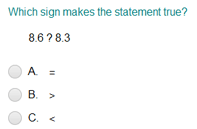Comparing and Ordering Decimals (up to Hundredths)
To compare decimal numbers, first write them in the place value table. If the decimal digits are not equal, then add zeros to the right of the last digit of the decimal number having fewer decimal digits.
Then, compare from left to right. Start with the whole part. The number with greater whole part will be greater.
If the whole parts are equal, compare the tenths. If the tenths are equal, then compare the hundredths and so on.
For example: Let’s compare 2.6 and 2.67.
Notice that the decimals do not have the same number of decimal digits.
Let’s write these decimal numbers in place value table and add extra zero (or zeros) to the end of the decimal number with less decimal digits.
| Ones | . | Tenths | Hundredths |
| 2 | . | 6 | 0 |
| 2 | . | 6 | 7 |
Now, notice that in both the numbers, whole parts are equal. Also, their tenths digit is the same.
So, we compare the hundredths digits.
The hundredths digit in 2.60 is 0 and in 2.67 is 7.
Now, 0 is smaller than 7.
So, 2.6 is smaller than 2.67.
A B C D E F G H I J K L M N O P Q R S T U V W X Y Z
Help
The correct answer is
Remember :
The smallest number is the one that comes first while counting.
Solution :
To arrange the given numbers in order from smallest to greatest, find the smallest number among all the given numbers.
21,27,23
21 is the smallest number.



